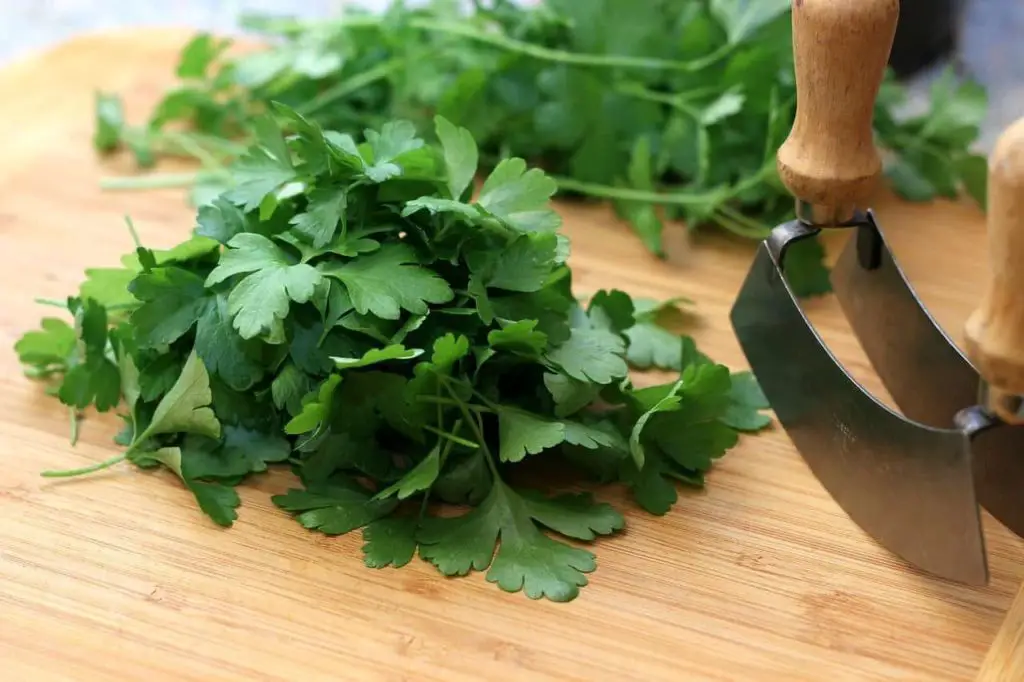Maybe you enjoy growing parsley all season long, and now that the weather is getting colder and the plant’s growth is slowing, you’re wondering how you can preserve what you have left.
Or perhaps you’re lucky enough to live somewhere where every season is parsley season, and you have so much parsley you don’t know what to do with it, but you don’t want it to go off.

No matter if your family adores parsley, you are very unlikely to use the whole crop within the growing season, whether you choose flat or curly parsley.
Even if you give some parsley away, and you add it to soups, meatballs, pizza, stews or salads with olives (see also How To Freeze Olives), you’ll still have some left.
Luckily, you can preserve the parsley by freezing it (see also How To Freeze Rosemary). You could also dry it, but not everyone has a dry and warm airing cupboard handy, or three weeks to spare waiting for it to dry out.
The Shelf Life Of Parsley
Fresh parsley, whether you’ve grown it and cut it yourself, or bought it fresh from a green grocer or store, will last about a fortnight at best.
Dried parsley has a shelf life of 2 years on average, but it can’t compete with the fresh version’s flavor.
When you freeze fresh parsley, you can store it for up to 6 months, making it a worthwhile practice as it’ll save you money in the long run, instead of buying fresh parsley all year-round, or trying to grow it yourself in the winter months.
How Do You Freeze Parsley?
Parsley is one of the easiest things you can freeze, and it will only take you a couple of minutes to prepare it for freezing.
How To Prepare Parsley For The Freezer
You can harvest parsley by using sharp scissors or garden shears, whatever you happen to have.
For best results, take the parsley from the base of the plant as a whole stem. Keep in mind that the younger leaves have a stronger flavor than the older ones.
The best time to harvest parsley is in the late morning, after any excess moisture has evaporated from the leaves.
Once you’ve got all the parsley you want to freeze, take them over to the sink. Wash the parsley gently in small bunches, taking care to get rid of any wilted leaves, pests, or soil.
Grab some paper towels and line a colander with them or cover a work surface. Allow the parsley to dry.
If this method doesn’t suit you, you can also use a salad spinner to get rid of excess moisture. Make sure the parsley is fully dry before you go any further.
Now you have two choices. You can either freeze it whole, or cut the parsley up first. If you’ll use parsley in marinades more than anything else, freeze it whole.
Otherwise, try cutting the parsley before you freeze it.
Freezing Parsley Whole
If you have a food vacuum sealer, you can freeze the parsley in vacuum freezer bags, which helps get rid of any excess air before freezing. This helps stop freezer burn.
If not, consider using two freezer bags. Lay the parsley flat into one bag, squeezing as much air from the bag as possible. Seal it, and put it inside the second freezer bag. Label and seal, and freeze.
Freezing Chopped Parsley
Finely chop the parsley, or throw it into a food processor to divide it. The easiest way to freeze chopped herbs – such as mint (see also How To Freeze Mint Leaves), oregano, and coriander – is to use an ice cube tray.
This way, you can also use the parsley straight from the freezer. It’s small enough to defrost very quickly, as long as you’re adding it to cooked dishes.
Divide the parsley between the sections, leaving a little room at the top. You can either add olive oil or water to the trays, making sure to leave some room for it to expand.
The olive oil will go cloudy when frozen and thawed, and it may separate, but you can use it for frying or cooking straight away.
Once frozen, transfer the cubes into freezer bags to save some space.
How Do You Thaw Frozen Parsley?
You can either use the parsley straight from frozen, or you can put some cubes into the fridge in a bowl, and let them thaw overnight.
Conclusion
Parsley is a fantastic herb which can be used in pretty much any dish that you can think of. Because you can freeze this herb (see also Can You Freeze Dill), this makes for endless flavor combinations, all year round.
